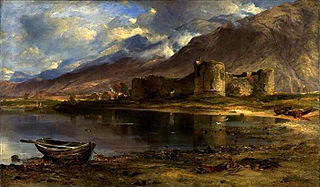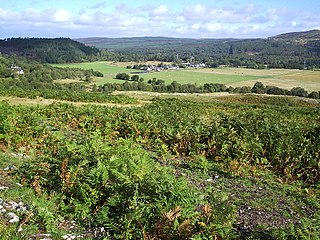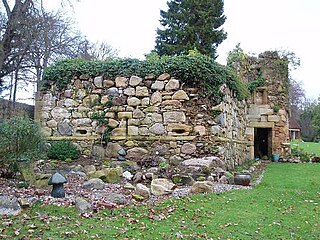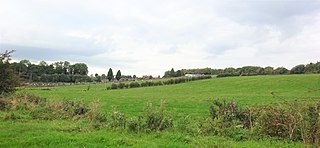
Clan Campbell is a Highland Scottish clan, historically one of the largest and most powerful of the Highland clans. The Clan Campbell lands are in Argyll and within their lands lies Ben Cruachan. The chief of the clan became Earl of Argyll and later Duke of Argyll.

James Graham, 1st Marquess of Montrose was a Scottish nobleman, poet, soldier and later viceroy and captain general of Scotland. Montrose initially joined the Covenanters in the Wars of the Three Kingdoms, but subsequently supported King Charles I as the English Civil War developed. From 1644 to 1646, and again in 1650, he fought in the civil war in Scotland on behalf of the King. He is referred to as the Great Montrose.

Archibald Campbell, Marquess of Argyll, 8th Earl of Argyll, Chief of Clan Campbell was a Scottish nobleman, politician, and peer. The de facto head of Scotland's government during most of the conflict of the 1640s and 50s known as the Wars of the Three Kingdoms, he was a major figure in the Covenanter movement that fought for the maintenance of the Presbyterian religion against the Stuart monarchy's attempts to impose episcopacy. He is often remembered as the principal opponent of the royalist general James Graham, 1st Marquess of Montrose.

The Battle of Inverlochy occurred on 2 February 1645 during the Wars of the Three Kingdoms when a Royalist force of Highlanders and Confederate Irish troops under the overall command of James Graham, 1st Marquess of Montrose, routed and largely destroyed the pursuing forces of Archibald Campbell, 1st Marquess of Argyll, who had been encamped under the walls of Inverlochy Castle.
The Battle of Tippermuir was the first battle James Graham, 1st Marquis of Montrose, fought for King Charles I in the Scottish theatre of the Wars of the Three Kingdoms. During the battle, Montrose's Royalist forces routed an army of the Covenanter-dominated Scottish government under John Wemyss, Lord Elcho. The government side took heavy losses.

Between 1639 and 1652, Scotland was involved in the Wars of the Three Kingdoms, a series of wars starting with the Bishops' Wars, the Irish Rebellion of 1641, the English Civil War, the Irish Confederate Wars, and finally the subjugation of Ireland and Scotland by the English Roundhead New Model Army.
General William Baillie was a Scottish professional soldier who fought for the Dutch and later commanded a regiment under Gustavus Adolphus in Sweden. Previously having seen service in the Scots-Dutch brigade, he joined the Scottish regiment of Colonel Alexander Hamilton in Sweden before going on to command a German regiment. Records of his service in the Swedish army fade out after 1633. He returned to Scotland in 1639. He served with the Army of the Covenant in 1639 at Duns Law with the rank of colonel.

The Battle of Kilsyth, fought on 15 August 1645 near Kilsyth, was an engagement of the Wars of the Three Kingdoms. The largest battle of the conflict in Scotland, it resulted in victory for the Royalist general Montrose over the forces of the Covenanter-dominated Scottish Parliament, and marked the end of General William Baillie's pursuit of the Royalists.

The Engagers were a faction of the Scottish Covenanters, who made "The Engagement" with King Charles I in December 1647 while he was imprisoned in Carisbrooke Castle by the English Parliamentarians after his defeat in the First Civil War.

The Battle of Carbisdale took place close to the village of Culrain, Sutherland, Scotland on 27 April 1650 and was part of the Wars of the Three Kingdoms. It was fought by the Royalist leader James Graham, 1st Marquess of Montrose, against the Scottish Government of the time, dominated by Archibald Campbell, 1st Marquess of Argyll and a grouping of radical Covenanters, known as the Kirk Party. The Covenanters decisively defeated the Royalists. The battlefield has been inventoried and protected by Historic Scotland under the Scottish Historical Environment Policy of 2009. Although Carbisdale is the name of the nearest farm to the site of the battle, Culrain is the nearest village.
Robert Monro, was a famous Scottish General, from the Clan Munro of Ross-shire, Scotland. He held command in the Swedish army under Gustavus Adolphus during Thirty Years' War. He also fought for the Scottish Covenanters during the Bishop's Wars in Scotland and commanded the Scottish Covenanter army during the Irish Confederate Wars. He was the author of a diary recounting his military experiences during the Thirty Years' War, published as Monro, His Expedition With the Worthy Scots Regiment Called Mac-Keys.

Clan Lamont is a Highland Scottish clan. The clan is said to descend from Ánrothán Ua Néill, an Irish prince of the O'Neill dynasty, and through him Niall Noigíallach, High King of Ireland. Clan Ewen of Otter, Clan MacNeil of Barra, Clan Lachlan, and Clan Sweeney are also descendants of Ánrothán. Traditional genealogy would therefore include Clan Lamont among the descendants of Conn Cétchathach.

Sir George Munro, 1st of Newmore (1602–1693) was a 17th-century Scottish soldier and member of parliament from the Clan Munro, Ross-shire, Scotland. He was seated at Newmore Castle. Between 1629 and 1634 Munro held command in the Swedish army during the Thirty Years' War, and from 1642 in the Scottish Covenanter army during the Irish Confederate Wars before changing his allegiance to the Royalist cause of Charles I in 1648 during the Scottish Civil War and Irish Confederate Wars.

The Whiggamore Raid was a march on Edinburgh by supporters of the Kirk faction of the Covenanters to take power from the Engagers whose army had recently been defeated by the English New Model Army at the Battle of Preston (1648).
Cumbernauld Bond was a pledge between eighteen Scottish noblemen who met at Cumbernauld in August 1640 to defend Scotland against extreme Presbyterians and to defend the National Covenant for the public good against those who used it predominantly for private gain. At political level it was an agreement to oppose the policies of Earl of Argyll who controlled the dominant political faction in Scotland. The most prominent pledger was the Earl of Montrose, others included Lord Fleming, the Earl of Marischal, and Lord Almond.

The Battle of Mauchline Muir was an engagement fought on 12 June 1648 between two rival factions of the Covenanters of Scotland. On one side were those who favoured The Engagement, known as Engagers, and on the other those who were opposed to the Engagement, and known as the Kirk party.
Glencairn's rising was a Royalist revolt in Scotland against the Protectorate of Oliver Cromwell from 1653 to 1654. It was led by William Cunningham, 9th Earl of Glencairn (1610–1664), who was given command of the Royalist forces in Scotland by Charles II. Initially successful it began to suffer divisions when John Middleton arrived to replace Glencairn as commander, resulting in a series of duels between officers. It was defeated when Thomas Morgan caught Middleton's army at Dalnaspidal on 19 July 1654. Although the rising was unsuccessful it forced a change of policy by the Cromwellian regime, which now looked for a reconciliation with former Royalists and Engagers.

Scotland under the Commonwealth is the history of the Kingdom of Scotland between the declaration that the kingdom was part of the Commonwealth of England in February 1652, and the Restoration of the monarchy with Scotland regaining its position as an independent kingdom, in June 1660.
Colonel John Cockburn was an officer in the Scottish Covenanter army in the late 1640s and early 1650s during the Wars of the Three Kingdoms. In this capacity he led Lowland soldiers against Montrose's Scottish Royalist forces during the First English Civil War (1642-1646), when the Covenanter parliament of Scotland was allied with the English Parliamentarians against King Charles I. Colonel Cockburn led the colourfully defiant but futile Scottish resistance at Hume Castle during the Third English Civil War (1649-1651), when a Parliamentary army led by Oliver Cromwell invaded Scotland after its Covenanter government had made an uneasy alliance with King Charles II.

The Battle of the Brig of Dee took place on 18–19 June 1639 at the Bridge of Dee in Scotland, and was the only serious military action of the First Bishops' War. It featured a Royalist force under James Gordon, 2nd Viscount Aboyne, opposed by Covenanters led by James Graham, 5th Earl of Montrose, and resulted in a Covenanter victory.
















